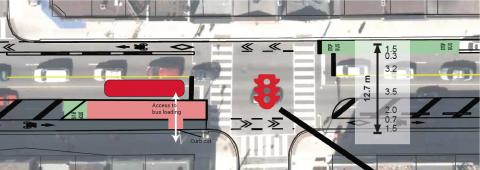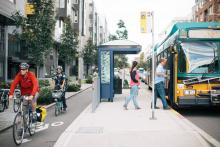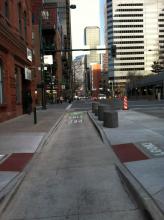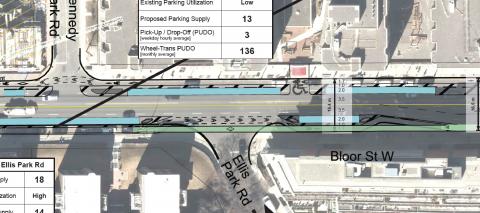Cycle Toronto submission on the Bloor St W extension
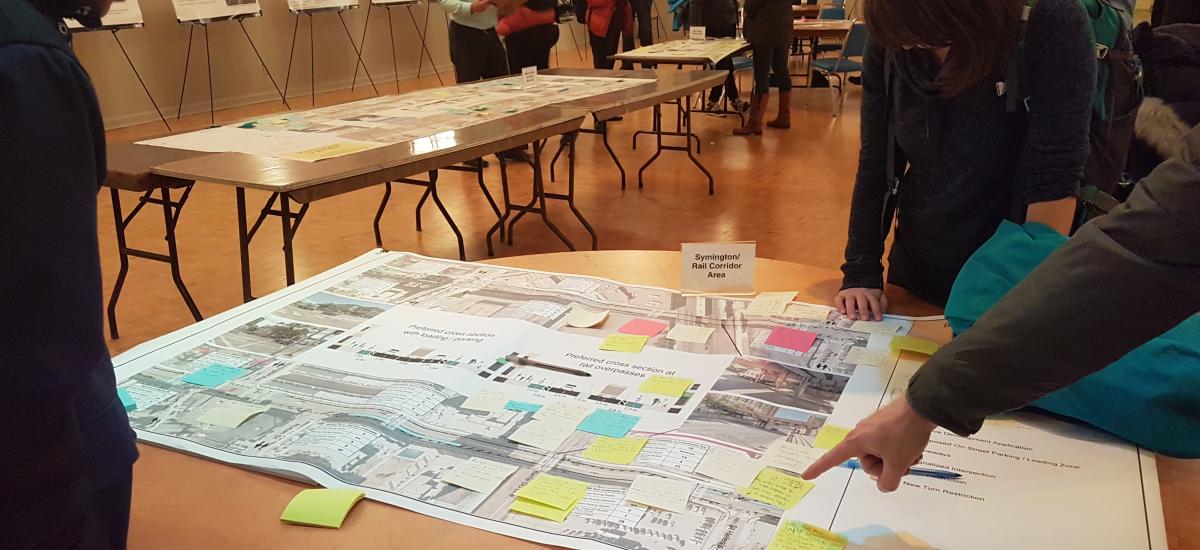
Cycle Toronto recently submitted feedback on the draft design of the Bloor West Bikeway Extension. We’re thrilled to see the highly successful and heavily-used bike lanes between Avenue Rd and Shaw St extended to Runnymede Rd and we’re strongly supportive of the planned extension.
This extension will grow transportation choices outside of the downtown core, connect neighbourhoods, and enable residents, businesses, and visitors to experience all the benefits that the current Bloor St bike lanes already provide.
We’ve highlighted some of our comments to the City below:
Physical Protection
Bollards mounted on curbs appears to be the minimum level of protection for most of the project area, with higher levels of protection in some areas. This will increase safety for all road users. However, there is room for improvement in some areas.
Through our review process we took into consideration which problems were the most pressing and where we would like to see improvements. We accounted for the installation timeline of 2020 while also supporting future upgrades.
In general, we propose ensuring there is consistent, physical protection throughout the entire design so as to create an ‘All Ages and Abilities’ (AAA) facility. Unprotected bike lanes are frequent targets of illegal parking, stopping, and idling.
- Missing protection: in some parts of the design, there does not appear to be any protection proposed. This occurs predominantly on the south side of Bloor St, which appears to have bollards only, rather than the typical treatment of bollards mounted on top of curbs, where the road widths are 12.5m to 12.8m.
- Protection underneath railway bridges: We highlighted these areas as requiring a higher level of protection, as the constrained area can be nerve-wracking to cycle under. We also recommended working with the appropriate jurisdictions (e.g., hydro companies, other city departments) to ensure that underpasses are well-lit, potholes are filled, and the roadway is repaved if there are serious deficiencies.
- Protection near intersections: Concrete islands are shown at many intersections. We recommended improving the level of protection by extending the concrete island as close as possible to the intersections to ensure that people driving slow down, watch for people on bikes, and can’t use the bike lane to turn.
- Intersection of Bloor St and Parkside Dr: A high number of drivers turn right from Bloor St to head south on Parkside Dr. We recommended exploring alternatives to the current design, such as an elongated right-turn lane and separate signal phase to accommodate turning traffic. This would keep the bike lane curbside with protection.
- Floating bus stops: We recommended installing floating bus stops wherever possible. This will help reduce conflicts between buses pulling in to the bike lane, provide a refuge for pedestrians waiting for the bus, and prevents other drivers from entering or stopping in the unprotected bike lane.
Possible design proposal of a floating bus stop on Bloor St at Havelock St. Loading can also be via the crosswalk.
| Example of a floating bus stop in Seattle, Washington. Photo by Adam Coppola. |
Floating bus stops can have curb cuts to ensure they are accessible to transit users with mobility constraints. Photo by Denver Department of Public Works (via NACTO). |
Light Phases, Turn Restrictions, Turning Management, and Traffic Flow
- Turning Radii: Wherever possible, we recommended tightening up the turning radii to ensure that people driving cars slow down when making a turn. This can be achieved by extending the concrete islands closer to intersections and/ or painting hatching around corners for a visual cue.
- Right-turn lanes and additional signals: Where vehicular traffic volumes are high, Cycle Toronto supports the installation of right or left turn lanes (space permitting) and separate signal phases for turning traffic to reduce conflicts between cyclists and turning vehicles.
- Bike lane orientation: In some locations, the bike lane diverts around parked cars. This generally works, but we highlighted the gradual hill on Bloor St between Runnymede Rd and Keele St, which could cause people to pick up speed when traveling eastbound. We recommended two options: make the curve more gradual or straighten out the bike lane.
Curbside Management
Cycle Toronto supports establishing pick-up and drop-off zones. A common complaint is that people park vehicles in space designated for cycling. This is caused by a lack of protection for the bike lane.
We suggested designating spaces for 15 minute stopping instead of longer-term parking.
Future Work
Our comments throughout our submission focused on efforts to complete for the 2020 installation. We also look forward to the future implementation of:
- Protected intersections, particularly at major intersections
- Enhancements to north-south connections to improve neighbourhood access to and from the Bikeway extension
- Further improvements to the underpasses, such as by elevating the bike lane and repaving the road if not within the scope of the current project
- Additional traffic signals, phases, and timing modifications
- Increased separation of the bike lane (e.g. raised curb)
- Raised bike lanes and crosswalks through minor intersections
Support
Our submission was co-signed by affected and interested Cycle Toronto ward advocacy groups, including:
If you value the advocacy work Cycle Toronto does, please consider becoming a member. Our members give us a strong voice at City Hall, allow us to deliver Street Smarts educational outreach, run cycling events, workshops and more. Learn about becoming a member.

